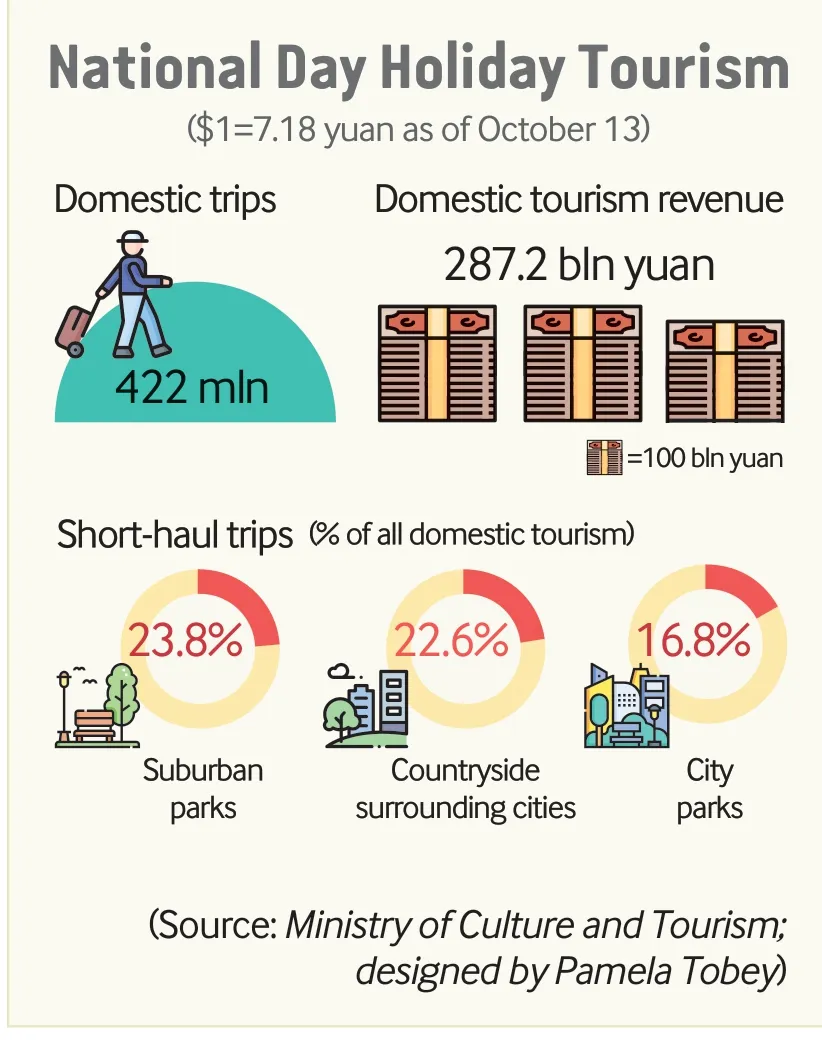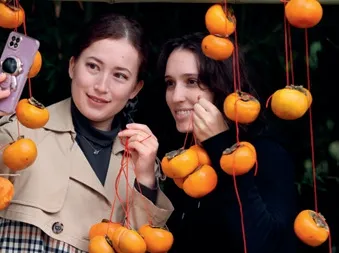Holiday in Colors
National Golden Week reveals new tourism trends By Zhang Shasha
Most overseas travelers have heard of China’s popular tourist cities, like the capital of Beijing, the bustling international metropolis of Shanghai, Chengdu,the home of pandas and hotpot, or even Dali,an idyllic city on the southwestern border of Yunnan Province.
But few may have heard of places like Hegang, a small city in the northeastern province of Heilongjiang, famed for its inexplicably low housing prices—reportedly less than 50,000 yuan ($7,030) for a two-bedroom apartment with a floor space of more than 70 square meters, more or less equal to the one-squaremeter cost of houses in megacities. Young wage-earners joke about the city as a place to fulfill their dreams of owning their own home.But there is much more to be discovered in Hegang. The former coalmining city is actually a hidden gem for food lovers, especially revered for its barbecue.
The hashtag “spending 300 yuan ($42) per day for a luxury hotel in Hegang” recently went viral on social media, which brought the city even further to the fore.
This year during the National Day holiday,a weeklong break starting from October 1,“unconventional travel” became a new trend.Instead of flocking to the recognized scenic spots, some people tended to visit less popular destinations like Hegang, which have a special style of their own but are not yet crowded by a sea of visitors each holiday.
Just as in Hegang, four- and five-star hotels in small northwestern cities, such as Linxia in Gansu Province, Haibei in Qinghai Province and Bayannur in Inner Mongolia Autonomous Region, saw their bookings jump by 10 times year on year during the holiday, according to online travel platform Qunar.com.
In explanation of the phenomenon, Dai Bin, President of the China Tourism Academy(CTA), said, “In the past, people traveled to scenic spots for their holidays. Now, tourists want experiences that help them relax.”
While traveling to niche destinations is one way to enrich the vacationing experience, it is not the only way. This year, the many travel options for the National Day holiday were classified into the colors green, red and gold.
Green
According to the Ministry of Culture and Tourism, suburban parks, countryside surrounding cities and city parks were the three most popular tourist destinations during the holiday,respectively attracting 23.8, 22.6 and 16.8 percent of all domestic tourists.
Moreover, instead of self-driving tours, more and more people explored low-carbon options such as cycling and citywalks.
Dai Zhengzong, a journalist and collector of bicycles in Beijing, said he is an “amateur” cyclist, but in fact has been cycling for more than 20 years. During the holiday, Dai rode through several classic routes in the city with his cycling teammates.
气瓶充装站原料储罐介质具有令人窒息、易燃、易爆、腐蚀等危险性质,一旦发生安全事故,人员无法有效靠近。GB/T 18442.6—2011《固定式真空绝热深冷压力容器第6部分:安全防护》和GB 50160—2008《石油化工企业设计防火规范》对远程紧急切断系统具有严格的要求。

“Despite the sudden drop in temperature, we saw many new faces on the team,” Dai told, adding that over the past three years, a growing number of people have joined their ranks. His bike-selling friends told him that sales of road and mountain bicycles have soared in recent years.
According to a report on National Day holiday consumption released by the JD Research Institute for Consumption and Industrial Development,purchases of road bikes increased by 273 percent year on year and that of bicycle accessories and cycling clothes rose by 170 percent.
“Cycling is really cool,” Dai said. “It makes me feel young and energetic and it’s low-carbon, healthy and sustainable, a cutting-edge idea for tourism.”
Low-carbon consciousness was also manifested in holiday consumption.According to Tmall.com, sales of energy-efficient household appliances on the e-commerce platform increased greatly this year, estimated to contribute to the reduction of 11,400 tons of carbon emissions.
Red
Red tourism refers to visiting sites of significance in the history of the Communist Party of China (CPC). Ahead of the 20th National Congress of the CPC, which was convened in Beijing on October 16, themed routes gained in popularity during the holiday.
According to online travel platform Fliggy.com, red tourism bookings during the National Day holiday rose by 1.6 times compared to during the weeklong Chinese New Year holiday in February. Bookings by people who were born in the 2000s increased by 4 times, indicating red tourism’s increased popularity among this demographic.
Golden

Tourists pose for a photo in Xinqi Village of Deqing County of Huzhou,Zhejiang Province,on October 5
The National Day holiday is also known as Golden Week. Here, the “golden” has several connotations. As the week coincides with early autumn, leaves are turning yellow, adding a golden atmosphere to the nation’s landscapes. It is also one of the most pleasant seasons of the year,a golden season for hanging out.
According to Trip.com, an online tourism service provider, this year’s per-capita spending of Chinese travelers during the National Day holiday increased by 30 percent year on year. The huge number of tourists created opportunities for scenic sites and service providers to increase profits.
In addition to traveling, people also give themselves a reward by shopping, both online and offline, and treat their family and friends after months of hard work.
As a result, the retail, food and beverage industries also saw a boom in consumption over the holiday. Statistics from the State Information Center showed that economic activity in business areas of major cities, including Beijing, Shanghai and Shenzhen and Guangzhou in Guangdong Province, were in recovery. A count taken of shoppers inside the nation’s major shopping centers at 8 p.m. on October 1 showed an increase of 26.8 percent year on year.
Agritourism, night economy, consumption related to pets and cross-border e-commerce also registered strong performance during the holiday.
“Consumption is the key to understanding the tourism economy,” Dai Bin told state broadcaster CCTV in an interview. Amid effective pandemic control and prevention, consumer behavior over the holiday speaks volumes on their huge potential for consumption.
However, as people become more selective in their consumption, the supply side must provide more attractive cultural and tourism products, he added. BR

